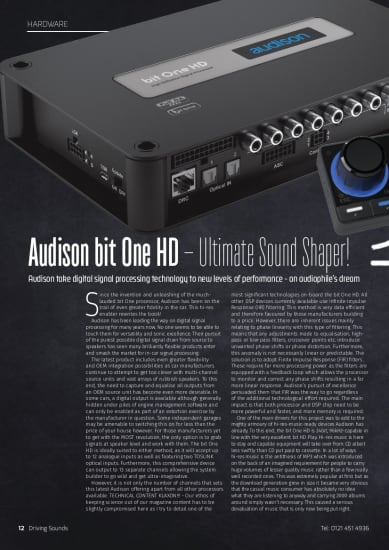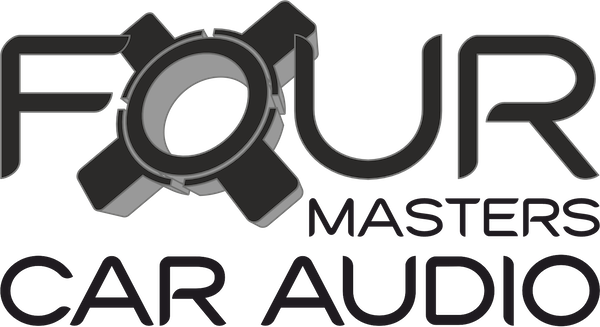
Audison bit One HD – Ultimate Sound Shaper!
Since the invention and unleashing of the much-lauded bit One processor, Audison has been on the trail of even greater fidelity in the car. This hi-res enabler rewrites the book!
Audison has been leading the way on digital signal processing for many years now. No one seems to be able to touch them for versatility and sonic excellence. Their pursuit of the purest possible digital signal chain from source to speakers has seen many brilliantly flexible products enter and smash the market for in-car signal processing.
The latest product includes even greater flexibility and OEM integration possibilities as car manufacturers continue to attempt to get too clever with multi-channel source units and vast arrays of rubbish speakers. To this end, the need to capture and equalise all outputs from an OEM source unit has become even more desirable. In some cars, a digital output is available although generally hidden under piles of engine management software and can only be enabled as part of an extortion exercise by the manufacturer in question. Some independent garages may be amenable to switching this on for less than the price of your house however. For those manufacturers yet to get with the MOST revolution, the only option is to grab signals at speaker level and work with them. The bit One HD is ideally suited to either method, as it will accept up to 12 analogue inputs as well as featuring two TOSLINK optical inputs. Furthermore, this comprehensive device can output to 13 separate channels allowing the system builder to go wild and get ultra-imaginative.
However, it is not only the number of channels that sets this latest Audison offering apart from all other processors available. TECHNICAL CONTENT KLAXON!!! - Our ethos of keeping science out of our magazine content has to be slightly compromised here as I try to detail one of the most significant technologies on-board the bit One HD. All other DSP devices currently available use Infinite Impulse Response (IIR) filtering. This method is very data efficient and therefore favoured by those manufacturers building to a price. However, there are inherent issues mainly relating to phase linearity with this type of filtering. This means that any adjustments made to equalisation, high-pass or low-pass filters, crossover points etc. introduce unwanted phase shifts or phase distortion. Furthermore, this anomaly is not necessarily linear or predictable. The solution is to adopt Finite Impulse Response (FIR) filters. These require far more processing power as the filters are equipped with a feedback loop which allows the processor to monitor and correct any phase shifts resulting in a far more linear response. Audison’s pursuit of excellence persuaded them that FIR was the way to go regardless of the additional technological effort required. The main impact is that both processor and DSP chip need to be more powerful and faster, and more memory is required.
One of the main drivers for this project was to add to the mighty armoury of hi-res-music-ready devices Audison has already. To this end, the bit One HD is 24bit, 96kHz-capable in line with the very excellent bit HD Play. Hi-res music is here to stay and capable equipment will take over from CD albeit less swiftly than CD put paid to cassette. In a lot of ways hi-res music is the antithesis of MP3 which was introduced on the back of an imagined requirement for people to carry huge volumes of lesser quality music rather than a few really well recorded ones. This was extremely popular at first but as the download generation grew in size it became very obvious that the casual music consumer has absolutely no idea what they are listening to anyway and carrying 2000 albums around simply wasn’t necessary. This caused a serious devaluation of music that is only now being put right.
I mention this, as streaming is becoming the new way for people to listen to music as well as exposing themselves to new music. Streaming services are of variable quality but premium services such as those provided by Qobuz or Spotify Premium are good enough to benefit from a competent and comprehensive DSP. In this way, high-quality streamed music can be enjoyed on the move (provided you have decent 4G or wi-fi coverage). In my opinion, this latter point will drive people back to storable media eventually and as memory becomes increasingly cost effective, I can see digital storage devices taking over and, provided people take care over the equipment they listen to, hi-res music will eventually be the norm. There are a number of aftermarket products available right now that boast hi-res, unfortunately those I have seen to date actually down sample hi-res files to 16bit, 44.1kHz – do check before you invest.
Returning to the bit ONE HD, on close examination of the product it is clear to see that Audison are committed to providing quality without compromise. No expense has been spared when selecting the finest available DSP chip and ultra low noise digital to analogue convertors. These devices can compromise all of the good work if they are not up to the specification of the rest of the electronics. A complete redesign of the software has also been undertaken. Setting up this product is not for the faint-hearted and car audio installers have plenty of things to learn about. Any software-oriented control surface has to be designed to enable an expert direct access to all of the controls without having to resort to looking in a manual too often. To this end, Audison have completely redesigned the software to make it simpler and more logical for your FOUR MASTER to set up. It is highly recommended that your installer uses the powerful Audison bit Tune to help your bit ONE HD undo any unpleasantness that has been introduced by the car manufacturer in order to make a silk purse from a sow’s cloth ear. This can include dodgy attempts at time-alignment as well as dynamically altering equalisation curves that change with listening level. To combat this, Audison recommends the deployment of its very excellent DRC controller. This offers the end user some top line adjustment of level, subwoofer, balance and fader and more importantly allows the user to select from four different presets. A DRC offers the opportunity to leave the level control on the head unit well alone and control everything from the compact control unit that can be mounted close to hand. The DSP is set up via a PC and although I would leave the experts to look after this, it is good fun to have a go yourself. Provided you have competent computer skills, a good ear and knowledge of the audio frequency spectrum there is no reason why you shouldn’t try, but do assign your result to a different memory to the one which contains your original installer’s setting.
Audison products are subject to continuous improvement and to this end your installer will have access to a dedicated portal from where firmware and software updates can be loaded. Your FOUR MASTER should contact you directly when critical updates become available and offer to upgrade your unit.
For the vast majority, the bit ONE HD will remain a “magic box” product that looks after sound shaping and is otherwise hidden from view and only touched by your FOUR MASTER when an improvement is made available. For the rare few, the powerful software can teach you an awful lot about sound if you have the patience required to make tiny adjustments and assess their affect on your sound.
Contact your local FOUR MASTER for further information: www.fourmasterscaraudio.co.uk
Find out what our partner, The FOUR MASTER Network, can do to bring Hi-Fi quality to your car. Simply put some brief details into the form below.
Not ready for that yet? You can use the same form to book a demonstration at your home, place of work or with your local FOUR MASTER
